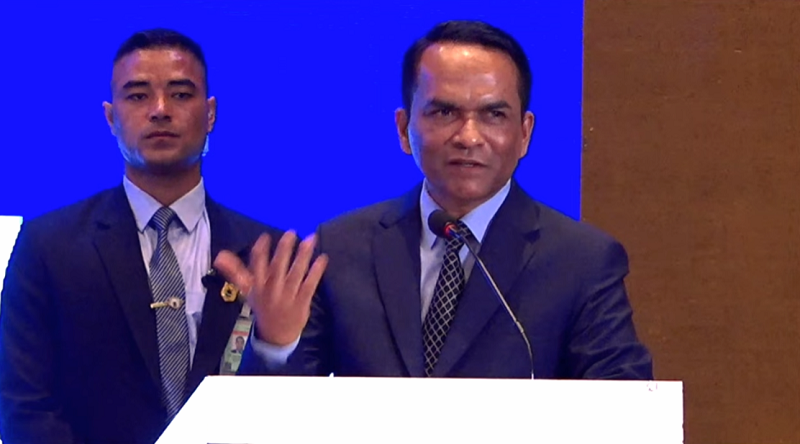Governor Poudel says Public Sector Spending Must Increase to Drive Economic Growth
9th November 2025, Kathmandu
Nepal Rastra Bank (NRB) Governor Dr. Biswo Nath Poudel has issued a clear and decisive call to action for the government, emphasizing the critical need to increase public sector spending as the primary catalyst for stimulating the nation’s economic growth.
Governor Poudel Economic Dialogue 2.0
Speaking at the Economic Dialogue 2.0, organized by the Federation of Nepalese Chambers of Commerce and Industry (FNCCI), Dr. Poudel articulated a classic Keynesian argument, positioning government expenditure as the vital engine required to inject momentum into a currently sluggish economy.
Public Spending: The Main Driver of Economic Expansion
Governor Poudel’s address centered on the fundamental role of fiscal policy in setting the pace for national economic activity. He explicitly stated, “Government spending is the main driver of economic growth. When the government spends more, demand increases.” This principle holds particular weight in developing economies like Nepal, where government investment in crucial infrastructure (such as roads, power, and communication) and social sectors (health and education) is essential to lay the groundwork for private sector success.
The Governor’s message is a pointed one to the government, suggesting that while the private sector has its own operational rhythm, the state must fulfill its duty as the initial spender to boost aggregate demand. Higher government spending, particularly on capital projects, creates jobs, increases the money supply in the hands of the public, and generates demand for raw materials and services, creating a crucial multiplier effect across the entire economy.
Dr. Poudel suggested a coordinated effort, stating, “Let the private sector move at its pace, and the government will also move at its own pace—eventually, we will all move forward together.” This highlights the need for a synchronized approach where accommodative monetary policy is complemented by decisive fiscal action to ensure resources are utilized effectively for national development and prosperity.
A Paradox of Abundance: Liquidity and Low Rates
A significant portion of the Governor’s speech was dedicated to addressing a critical paradox currently facing the Nepali economy: the coexistence of low interest rates and abundant liquidity alongside sluggish private sector credit growth. Dr. Poudel provided striking statistics to back his claim of financial stability:
High Liquidity: The central bank currently holds over NPR 8 trillion in liquidity, indicating that commercial banks have substantial funds available for lending.
Strong Reserves: Foreign reserves stand at more than NPR 22 trillion, a figure he proudly noted is “higher than our neighboring countries” when measured against import coverage ratios, affirming Nepal’s external sector stability.
Low Interest Rates: He emphasized that “Interest rates are very low,” signaling that the monetary policy environment is highly conducive to private borrowing and investment.
These indicators confirm that the central bank has successfully managed the monetary side of the economy, ensuring low cost of capital and high fund availability. The problem, therefore, shifts from monetary restrictions to a lack of demand for loans and insufficient aggregate demand in the real economy, which can only be effectively addressed through the government’s fiscal spending capacity.
The Private Sector Challenge: Production and Confidence
While acknowledging the private sector’s expectation of support, Dr. Poudel also issued a direct challenge, urging business leaders to rise to the occasion. He stressed that private sector engagement remains crucial to enhance production and employment generation. The immense liquidity and low-rate environment are designed to be an invitation to invest, and the Governor encouraged entrepreneurs to work “with high morale, increase production, and create jobs.”
However, the Governor also shed light on one of the underlying issues causing low loan demand: the current state of credit quality. He revealed that around 150,000 individuals have been blacklisted, which directly reduces the pool of eligible borrowers and adds a layer of caution to the banking sector’s lending appetite. This statistic illustrates that while liquidity is available, credit risk remains a real constraint on the expansion of credit and highlights the challenges faced by both borrowers and lenders in the current climate.
Furthermore, the central bank’s commitment to maintaining a favorable interest rate environment comes at a cost, as revealed by Dr. Poudel. The NRB spent NPR 25 billion to maintain the lower limit of the interest rate corridor, a mechanism used to guide short-term interest rates. This is a significant expenditure undertaken to stabilize the financial system and keep the cost of borrowing low, further underscoring the central bank’s supportive role.
Conclusion: A Call for Fiscal and Private Sector Synergy
Governor Dr. Biswo Nath Poudel’s speech was a comprehensive articulation of the current economic environment. It confirmed the monetary sector’s robust health, marked by high foreign reserves and ample liquidity, but exposed a critical weakness in the fiscal execution and private sector confidence. The path forward, according to the central bank chief, requires the government to rapidly accelerate its spending, channeling public funds into projects that boost demand. Simultaneously, the private sector must capitalize on the low interest rates and abundant liquidity by overcoming prevailing hesitancy, increasing production, and leading the charge in job creation to ensure the entire economy moves forward in unison.
For More: Governor Poudel Economic Dialogue 2.0








